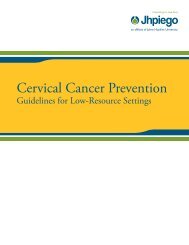Manual for Male Circumcision under Local Anaesthesia
Manual for Male Circumcision under Local Anaesthesia
Manual for Male Circumcision under Local Anaesthesia
Create successful ePaper yourself
Turn your PDF publications into a flip-book with our unique Google optimized e-Paper software.
<strong>Male</strong> circumcision <strong>under</strong> local anaesthesia<br />
Version 3.1 (Dec09)<br />
• working to end harmful sexual practices, such as female genital<br />
mutilation and “dry sex”;<br />
• sharing financial resources with women, and supporting the notion<br />
of shared property rights;<br />
• supporting women’s full participation in civil society, including their<br />
access to social, political and educational opportunities, many of<br />
which have a direct or indirect impact on women’s health;<br />
• supporting the rights of daughters to the same health care,<br />
education, and respect as sons.<br />
Who should provide sexual and reproductive health services and<br />
in<strong>for</strong>mation to boys and men<br />
A wide range of people and organizations can provide sexual and<br />
reproductive health services and in<strong>for</strong>mation to boys and men. Some<br />
of the key providers are listed below. 4<br />
• Parents. Ideally, boys and young men should receive in<strong>for</strong>mation<br />
and basic education on sexual and reproductive health from their<br />
parents. However, available data suggest that less than half of<br />
boys and young men discuss HIV/AIDS, STIs or family planning<br />
with their parents.<br />
• Teachers. Many adolescent boys now receive some education on<br />
health, family life and sexuality in school. However, <strong>for</strong> some, the<br />
instruction comes after they have begun having sexual<br />
intercourse.<br />
• Peers. Boys and men of all ages often get in<strong>for</strong>mation on sexual<br />
and reproductive issues from their peers. Much of this in<strong>for</strong>mation,<br />
however, may be inaccurate. One approach is to educate key<br />
youth leaders, who can then pass on accurate in<strong>for</strong>mation to their<br />
peers. This has to be an ongoing process, to reach each new<br />
generation or group of young men.<br />
• Community-based organizations. Places of worship and youth<br />
groups are important sources of in<strong>for</strong>mation, and also provide an<br />
opportunity <strong>for</strong> counselling and skill-building in relation to sexuality,<br />
relationships, marriage and parenting. In some cases, the only<br />
method taught <strong>for</strong> preventing pregnancy and STIs is sexual<br />
abstinence, despite the fact that young people find it difficult to<br />
adhere to abstinence. As a result, they may not know how to<br />
protect themselves from risk when they become sexually active. 5, 6<br />
• Family planning clinics. Some family planning clinics reach out<br />
to men, particularly to the partners of their female clients. The<br />
availability of male health care providers and separate consultation<br />
sessions <strong>for</strong> men may encourage men to use these services.<br />
Although family planning clinics have a long history of providing<br />
both medical and counselling services, many men see them as<br />
being only <strong>for</strong> women; equally, some providers may be<br />
uncom<strong>for</strong>table serving men.<br />
• Youth-friendly services. Some countries have developed<br />
programmes that specifically address the needs of young people,<br />
Linking male circumcision and other male SRH services Chapter 2-6
















